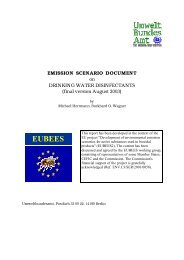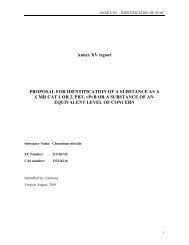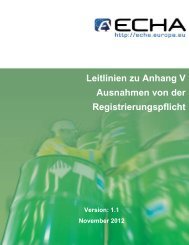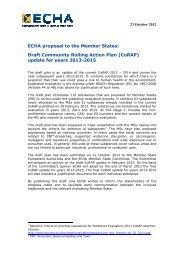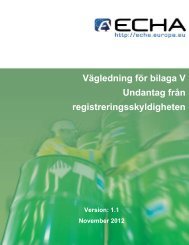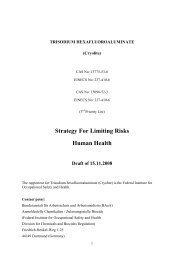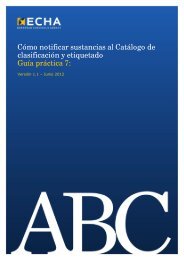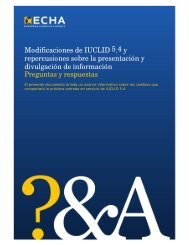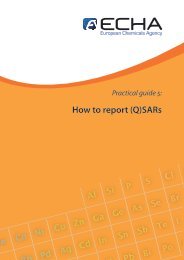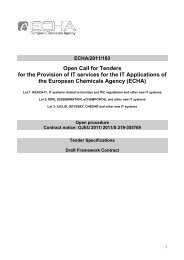Data Submission Manual part 14 – How to Prepare ... - ECHA - Europa
Data Submission Manual part 14 – How to Prepare ... - ECHA - Europa
Data Submission Manual part 14 – How to Prepare ... - ECHA - Europa
You also want an ePaper? Increase the reach of your titles
YUMPU automatically turns print PDFs into web optimized ePapers that Google loves.
42 <strong>Data</strong> <strong>Submission</strong> <strong>Manual</strong> Version: 2.0<br />
For more instructions on the selection of these codes, please consult the Guidance on the<br />
application of the CLP criteria which can be found on the <strong>ECHA</strong> website.<br />
For the “Specific target organ <strong>to</strong>xicity - Single exposure” and “Specific target organ<br />
<strong>to</strong>xicity - Repeated exposure” hazard classes, you have <strong>to</strong> indicate in the field “Affected<br />
organs” the primary target organs. It is recommended <strong>to</strong> include no more than three<br />
primary target organs for practical reasons and because the classification is for specific<br />
target organ <strong>to</strong>xicity. If more target organs are affected it is recommended that the<br />
overall systemic damage should be reflected by the phrase “damage <strong>to</strong> organs” (<br />
Figure 50).<br />
If the affected organ is unknown indicate “unknown” it in the field “Affected<br />
organs”.<br />
The route of exposure should only be specified if it is conclusively proven that no<br />
other route of exposure causes the hazard. Supporting evidence can be attached<br />
<strong>to</strong> section 13 of IUCLID 5 in a separate endpoint study record (unless it is already<br />
specified in Annex VI <strong>to</strong> the CLP Regulation or justified in the SDS provided by the<br />
supplier).<br />
Two routes of exposure can be specified. This means that in case all three routes<br />
of exposure cause the hazard, the route of exposure field shall remain empty.<br />
Figure 50: Specify the affected organ<br />
For “Specific target organ <strong>to</strong>xicity <strong>–</strong> single” and “Specific target organ <strong>to</strong>xicity <strong>–</strong><br />
repeated” either the three fields “Hazard category” and “Hazard statement” and<br />
“Affected organs” should be filled in, or the field “Reason for no classification”<br />
should be filled in (<br />
Figure 50).<br />
Substances which have a harmonised classification, or are fulfilling the criteria for<br />
classification, as carcinogenic, mutagenic, reproductive <strong>to</strong>xicants or substances<br />
fulfilling the criteria for STOT-SE or STOT-RE Category 1 do not qualify for an<br />
alternative chemical name.<br />
5.7.2.3. Classification <strong>–</strong> Specific concentration limit<br />
Harmonised classification has <strong>to</strong> be applied: if your substance has harmonised specific<br />
concentration limit(s), you shall specify it in this IUCLID 5 block (<br />
Figure 51).<br />
If you propose <strong>to</strong> set specific concentration limit(s) under the strict condition of Article<br />
Annankatu 18, P.O. Box 400, FI-00121 Helsinki, Finland | Tel. +358 9 686180 | Fax +358 9 68618210 | echa.europa.eu






